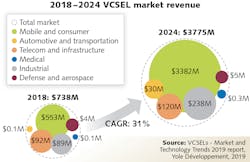The vertical-cavity surface-emitting laser (VCSEL) is certainly having a moment of success—or, more accurately, moments, since there are so many hundreds of millions of them in applications ranging from data communications to optical mice, face recognition, and other sensing applications.
Over the years, a lot of work in many different places has been performed on the concept and development of VCSELs, most notably in the beginning by Kenichi Iga and colleagues at the Tokyo Institute of Technology in the late 1970s. The technology arrived at Bell Labs in 1989 as the byproduct of an effort to develop optical computers. One of the Bell Labs VCSEL researchers, Jack Jewell, went on to found VCSEL makers Vixel in 1993 and Picolight in 1995.
Honeywell began research on VCSELs in 1993 and commercialized them in 1996. In the 1990s, Finisar was developing its own line of VCSELs, plus, in 2004, it acquired the Honeywell VCSEL group (II-VI has recently acquired Finisar). In 2015, Lumentum become a leader in VCSEL production following its spinout from JDSU (which had acquired Picolight in 2007).
This very narrow selection of the business history surrounding VCSELs might give the impression that the VCSEL market is consolidating and could well become more rigid with fewer and larger players. In fact, the market has exploded, with numerous types of VCSELs serving or set to serve a rapidly diversifying customer base. And new VCSEL companies are forming or companies in related fields are entering the fray. Global companies worth watching include Osram (which acquired Vixar), Trumpf (which acquired Philips Photonics), and LED giant Sanan Integrated Circuit (which is making major new investments in VCSELs), and also more specialized startups using VCSELs for lidar and other 3D sensing applications, such as Ouster and Vertilite.
According to Yole Développement (Lyon, France), the global VCSEL market should surpass $3.7 billion by 2024, growing at a 31% CAGR between 2018 and 2024. The consumer market segment contributes to these impressive figures with a market value of $3.4 billion by 2024 (see figure).
We’ll be addressing the rapidly expanding market in a panel at the Lasers & Photonics Marketplace Seminar. Panel moderator John Dexheimer, from LightWave Advisors, says that VCSELs are proving to be a disruptive force, broadening the wave of innovation at all levels for all optoelectronic semiconductors and supporting optics.
He adds that the ecosystem around VCSELs is rich with opportunities for complementary materials and fab partners, design firms, metrology, optics, filters, and optical assembly/integration needed for the system builds. VCSEL applications are driving optics company growth as more diverse applications launch and as a variety of price/performance devices proliferate.
For example, VCSELs are entering several high growth markets such as the 3D printing market and biometrics imaging, which couples VCSELs and advances in diffractive optics. New VCSEL products are being launched in InP, GaN, and DN-EPI that enable an array of wavelengths and products not doable in existing GaAs VCSELs. The acceleration in VCSEL adoption will also drive the ecosystem to create new applications and price/performance incentives for edge-emitting lasers.
For more data, insights, and market opportunities in this “VCSEL moment,” join us at the 32nd Lasers & Photonics Marketplace Seminar, to be held on February 3, 2020, during SPIE Photonics West.
About the Author

Conard Holton
Conard Holton has 25 years of science and technology editing and writing experience. He was formerly a staff member and consultant for government agencies such as the New York State Energy Research and Development Authority and the International Atomic Energy Agency, and engineering companies such as Bechtel. He joined Laser Focus World in 1997 as senior editor, becoming editor in chief of WDM Solutions, which he founded in 1999. In 2003 he joined Vision Systems Design as editor in chief, while continuing as contributing editor at Laser Focus World. Conard became editor in chief of Laser Focus World in August 2011, a role in which he served through August 2018. He then served as Editor at Large for Laser Focus World and Co-Chair of the Lasers & Photonics Marketplace Seminar from August 2018 through January 2022. He received his B.A. from the University of Pennsylvania, with additional studies at the Colorado School of Mines and Medill School of Journalism at Northwestern University.
